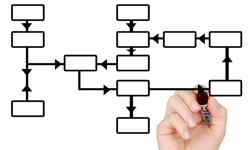To his credit, Peter didn’t try to pretend that the outlook for print was anything other than challenging. The European newsprint sector is consuming 25% less tonnage than in 2007, and, if the current trend continues, that could reach 32% by the end of the year. The decline in demand for graphic papers was of a similar magnitude.
Print runs, down; paginations, down; paper quality, down. Dailies becoming weeklies, weeklies turning into fortnightlies, fortnightlies into monthlies. Aaaaaaaaaaaaaaaaaaaaagh!!!!!
As a result there will, inevitably, be further consolidation in the print and paper industry. Of course that will be painful, but once the market has restructured, then there should be a sustainable business for the next generation of suppliers, because, whilst print and paper may no longer be a growth sector… it is still a very large sector.
B2B might have disappeared down the digital road, but the consumer magazine sector was still 84% print. The national newspaper sector might be trumpeting the gazillion unique users visiting their websites, but they still make the bulk of their revenue from … print. And the growth of free magazines (Time Out’s circulation went from 25,000 to 300,000 copies when it switched to free circulation last year) shows there is still an enduring demand for paper.
In Peter’s view, when we come through this recession and the digital dust has settled, there will still be a printed product, but publishers will need to continue to rethink their print offering to ensure it has “greater impact; it’s got to make you sit up; it’s got to slap you in the face,” said Peter. “Print needs to be less speculative and more spectacular.”
The future of print lies partly in the recognition on the part of publishers that print is not the best platform for all types of content. In the seminar, The Drum’s Nick Creed explained how his title now has a clear demarcation; all news goes online, while the print magazine focuses on analysis.
The main themes of the Denmaur sponsored seminar were:
* Less is more, and the more targeted use of print
* Cut costs, and help the environment, by reducing waste
* the need for ‘print’ to be more impactful
Happily, these three strands all come together in the shape of digital printing. Digital printing has been around a while, but there were quality issues early on and the perception took hold that digital printing was poor quality.
But no longer, apparently. Richard Owers of Pureprint Group hailed recent advances in digital print as some of the most exciting developments since Gutenberg. Quality is no longer an issue!
The idea that variable data publishing means that a print run of 10,000 can include 10,000 unique pieces is not new. We’ve all been aware of the theoretical advantages of digital print for ages. The difference now, says Richard, is that it’s achievable. Digital printing, he continued, enables more creativity and experimentation without the high fixed costs associated with more traditional printing technology.
The best printers were now educating publishers on how to print less and spend less, because they know that a viable publishing sector, tightly controlling its costs, is vital for the continued survival of the print and paper sector as a whole.












